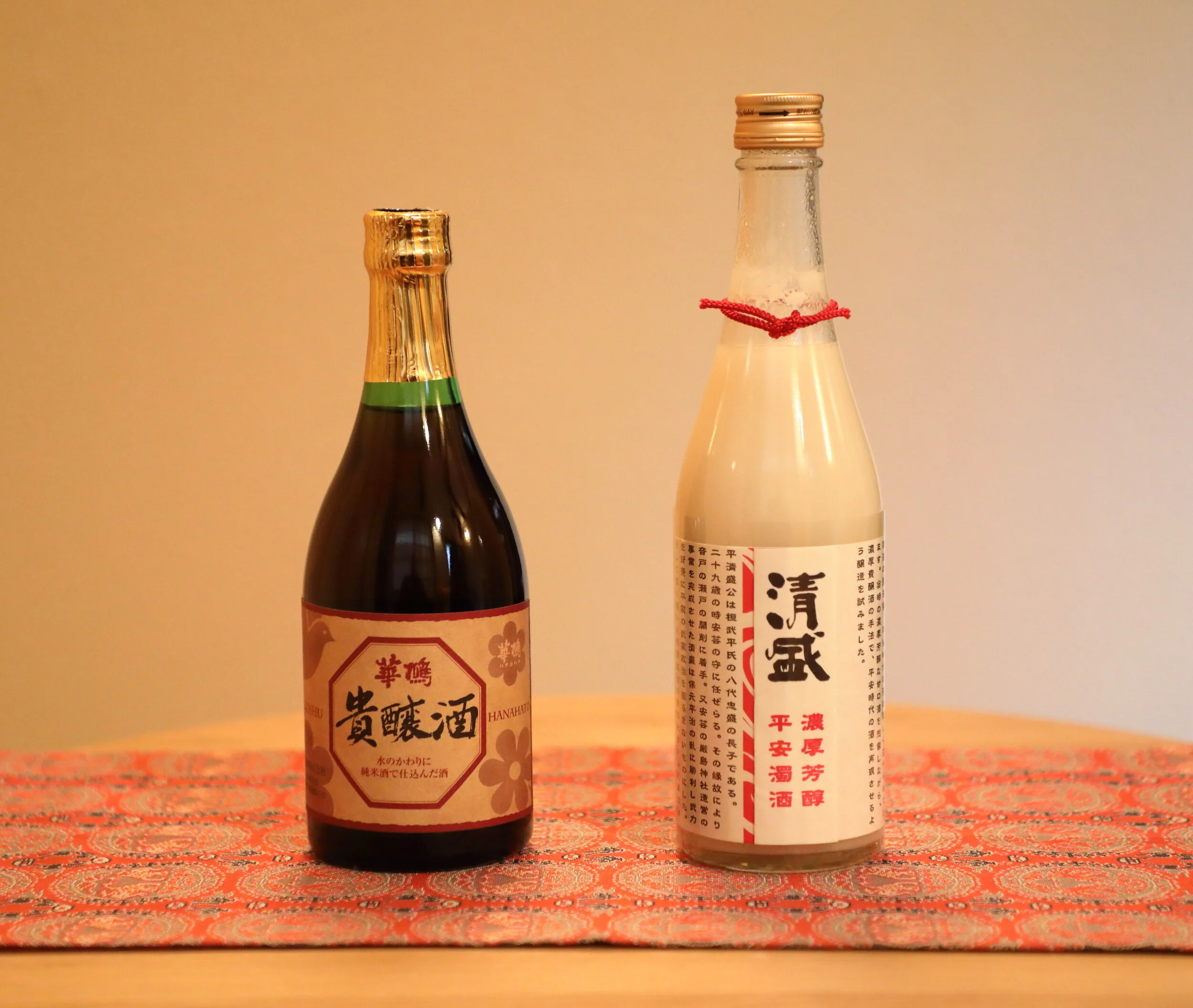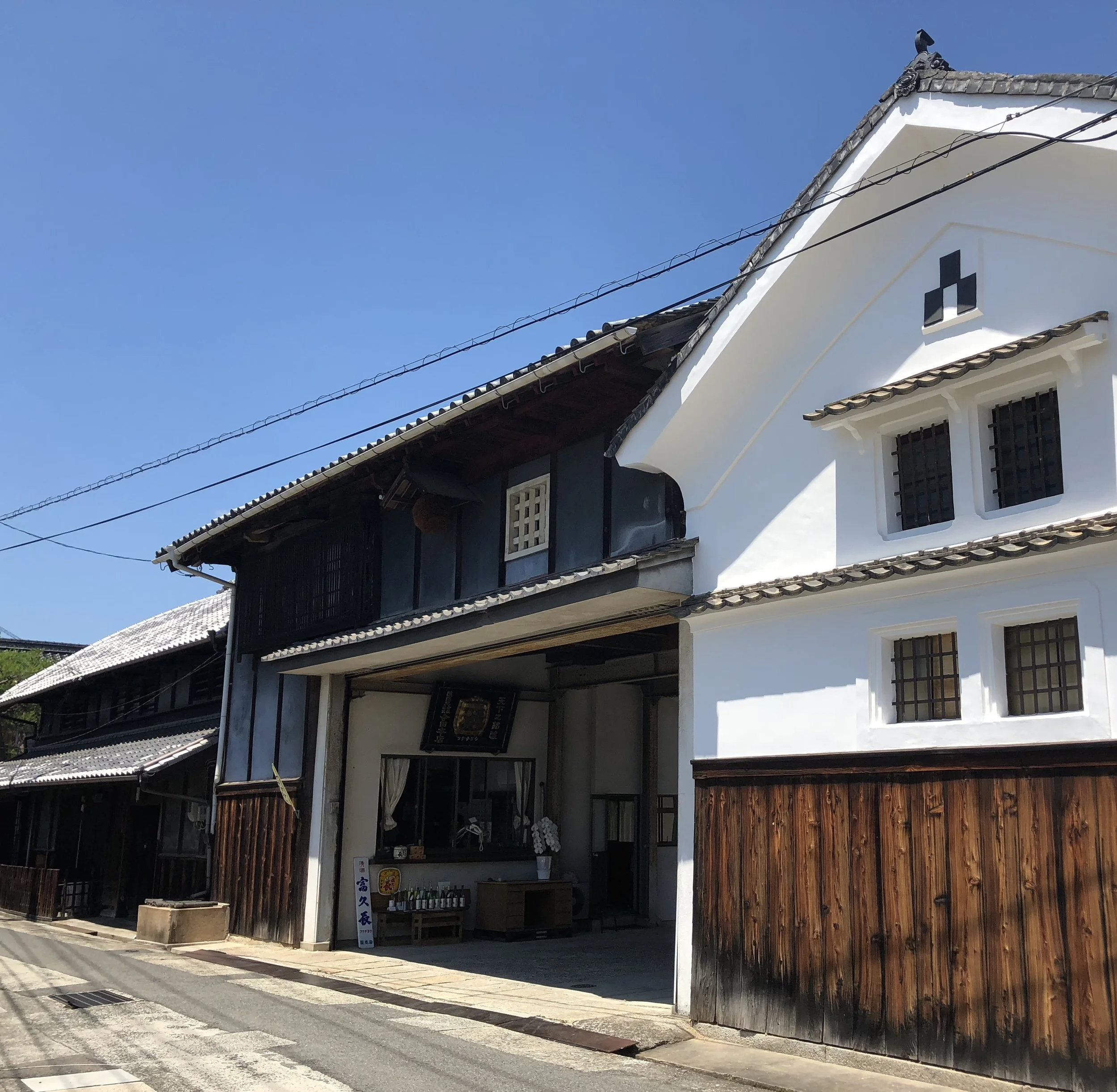Enoki Shuzo’s Twice-Brewed & Aged Kijoshu Sake
The first modern brewer in Japan of rich, double-brewed and aged kijoshu sake, Enoki Shuzo continues to lead a growing trend for this rare category of sake through its many delicious innovations.
In 1974, Enoki Shuzo became the first sake brewer in the modern era in Japan to make twice-brewed sake, which it calls kijoshu. Kijoshu entails making a fresh batch of steamed rice, koji mold-inoculated rice, and yeast starter, and mixing them with existing sake instead of water. This enriched mash is then fermented for the standard thirty or so days. The result is a sweeter, extra rich and creamy sake; a sort of very easy-to-drink rice cider, especially the unpasteurized version, which is slightly fizzy. Branded “Kiyomori Heian” by Enoki Shuzo because of this type of sake’s ancient origins in Japan’s Heian Period (794-1185), it is today the brewery’s most popular sake. (Pictured on the right in the title block above.)
The higher sugar content in kijoshu—double that of regular sake—lends kijoshu to being aged, and Enoki Shuzo was also the first sake brewer in recent times to age sake. Its flagship aged kijoshu, labeled “Hanahato,” is aged for eight years. (Pictured to the left in the title block above.) It has a delightful floral fragrance and deep, rich flavor, which combined with its sweetness and fortified alcohol content of 16.5%, make it similar to a sherry or port wine. But being made from a grain rather than from a fruit like sherry and port, “Hanahato” has a heartier flavor and is something you can drink all through a meal instead of mainly before or at the end of it. “Hanahato” goes particularly well with rich Western types of dishes—foie gras, grilled steaks, and stews and also with chocolatey desserts and creamy custards. Its delicious complexity and affinity for food has earned “Hanahato” a Gold Medal at the International Wine Challenge ten times in the last two decades.
Enoki Shuzo was founded in 1899 on Kurahashijima Island. Located just opposite Hiroshima City in Hiroshima Bay, it is one of the largest islands in the Seto Inland Sea. Because of its size and strategic location, Kurahashijima, along with its neighboring island Etajima and the nearby mainland coast of Honshu Island, is part of the Kure Naval Center. Established in 1888, the Kure Naval Center was Japan’s greatest pre-war naval site, and today these districts remain key naval administrative and shipbuilding centers. One might think that Enoki Shuzo made kijoshu for the naval sailors and other seamen who live in the area given how often these professions are associated with sherry, port wine, and other sweet, rich drinks like rum. But kijoshu’s origin has more to do with the nature of the Enoki family. The brewery is currently run by fourth generation brewer and president Toshihiro Enoki and his sister Mariko. As Mariko says, “We are a curious family interested in many things, and when we hear about a new challenge, we want to try it.” This curiosity is evident in the fifty or so different styles of sake the Enokis make within both the standard and kijoshu categories of sake.
The unusually broad range of sake that Enoki Shuzo has on offer is surprising given that the brewery is a small, family business. Leading the brewing process are Toshihiro and Tadashi Fujita, the toji (master brewer), who has been part of the extended Enoki family for the last twenty years. They are helped by one other full-time brewer. Mariko and the three people who help her run the business also pitch in during the brewing season, which runs from October through April, when all hands are needed on deck, so to speak.
Making sake by such a small team is possible because at its heart it is a fundamentally simple process. Rice is steamed, some of that rice is inoculated with koji mold and cultivated in a climate controlled muro room for two days to create enzymes that will break down the starch in the rice into sugar, a shubo yeast starter is created to turn the sugar into alcohol, and the koji-rice, shubo yeast, and the remaining steamed rice are mixed with water, or already-brewed sake in the case of kijoshu, and allowed to ferment. But within that process the Enokis creatively experiment with all of its dimensions, including the types of rice used, the degree to which the rice is polished, the type of koji mold used, the method by which the shubo yeast starter is created, and even the type of water used. The Enokis use both hard water from a well on the property and soft water they obtain from a spring in the nearby mountains. When brewing kijoshu, the Enokis also vary the style of pre-existing sake used and the period of time it is aged. The only constant is the Enokis’ use of Yeast #9 for all of their sake. Discovered in Kumamoto on Kyushu Island in 1953, this yeast strain revolutionized sake-making by helping sake brewers make sake with the entrancing aromas and bright, clean, nuanced flavors associated with the ginjo and dai-ginjo styles of sake popular around the world today. Yeast #9 is especially important for making twice-brewed and aged sake because of the way it balances the sweet, rich, hearty characteristics of kijoshu.
The Enoki Shuzo sake brewery is situated on a narrow back street in the old port town of Ondo at the base of one of the two bridges that links Kurahashijima to the Honshu Island mainland. There, Mariko will gladly lead you through a tasting of as many of Enoki Shuzo’s sake as you like, somewhat mischievously delighting in surprising you with all of the hidden flavors of sake that the brewery reveals and creates; a myriad combination of light and mellow, bright and acidic, and rich and complex flavors.
The first tasting is a classic junmai dai-ginjo sake. Made with all the hallmarks of a great junmai dai-ginjo—Yamada-Nishiki rice polished down to a low 35% of its original volume and brewed slowly using Yeast #9—it is a light, refreshing sake layered by a heavenly fragrance on top and a smooth subtle creaminess underneath. Although Mariko tosses it off by saying that Enoki Shuzo brews it “because everyone makes this type of sake; it’s the one that kicked off the dai-ginjo sake revolution 30-40 years ago,” it is a testimony to the skill and virtuosity with which the Enokis make delicious sake. It is also an important first taste because it is one of the sake used to make kijoshu.
The next group of sake are more single-brewed sake, but there is nothing standard about them. For example, Enoki Shuzo makes three junmai ginjo sake; sake that is made with rice polished down to 55-60% of its original volume. Each is made with a different type of rice. One is made with richly-flavored Omachi rice, another with a local heritage sake-making rice called Hattan-Nishiki that produces a brighter, more acidic sake, and the last is made with a simple eating rice called Nakate-Shinsenbon to create a table sake. The Hattan-Nishiki rice version, in turn, is also offered as a fuller-bodied yet still bright and refreshing muroka genshu (unfiltered) type of sake. Then there is another muroka genshu sake that is made with Gin-no-Sato rice, which the Enokis are growing organically themselves as they continue to expand their repertoire of experiments and innovations. Gin-no-Sato is a new strain of rice that was developed in 2007 to produce even better ginjo style of sake. It also grows well in warm climates like that of Hiroshima prefecture where Enoki Shuzo is located.
In the twice-brewed kijoshu category of sake there are an equal number of variations. Kijoshu is a growing trend in Japan. Still, there are less than thirty brewers of this category of sake, and no other brewer makes as many different styles of kijoshu as Enoki Shuzo. Among these are “Kijoshu Nouveau,” a relatively young kijoshu that is very full-bodied yet also bright and acidic because it is not pasteurized or filtered. Mariko says it is a popular product at steakhouses, especially those specializing in wagyu beef. Other kijoshu sake include a slightly richer kijoshu that is first brewed with Yamada-Nishiki rice, then brewed again with stronger-flavored Omachi rice and aged for three years, and a more complex kijoshu that is aged one to two years in oak barrels. Enoki Shuzo’s premier product is a kijoshu that is made with kijoshu. In other words, a new batch of sake is mixed with existing kijoshu, effectively making it a thrice-brewed sake. It is aged for twenty-eight years, part of that time in oak barrels and the rest of the time in bottles.
As kijoshu ages it becomes darker in color and richer, more complex in flavor, enhancing its interest and versatility as an accompaniment to all kinds of foods and cuisines. The deep umami that it develops over time also make a kijoshu like “Hanahato” a great cooking sake. It can even perform as a substitute for hon-mirin. Although its sugar content of around 7% is significantly less than that of an authentic hon-mirin, which has a sugar content of around 48%, when using “Hanahato” as a replacement for hon-mirin just add a bit more sugar for a recipe that calls for hon-mirin and/or boil the “Hanahato” down to the desired consistency and taste. This is what Mariko does, who says she only uses sake and sugar when cooking Japanese dishes. And do not forget to sip some while cooking. Like all sake, “Hanahato” is meant to be enjoyed for itself, not only with food.
Story & Photos: Tom Schiller
Enoki Shuzo 榎酒造
2-1-15 Ondocho Minamiondo, Kure, Hiroshima Prefecture 737-1205
Tel: +81 (0823) 52 1234
Web: hanahato.ocnk.net
The shop at Enoki Shuzo is open Monday to Friday from 9:00 to 19:00. On Saturdays it is open from 10:00 to 18:00. Please call Mariko or send her an email at mariko@hanahato.co.jp to set up an appointment in advance and be sure she has the time to take you through the broad range of possible tastings of the brewery’s sake.
Getting There
To get to Enoki Shuzo, first go to Kure City, which can be reached by the local Kure Line train starting either from the east at Mihara City and other local stops or from the west starting at Hiroshima City. From Kure City take the Kurahashijima Line train to Ondo Shimin Center. Enoki Shuzo is about a 3-minute walk from there.




